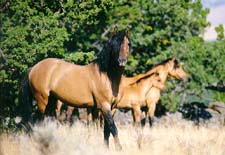Kiger Mustang
N/A
Fri, 4th July, 2025 - 7:22 am GMT
Sponsor Ads:

Alternative Name
N/ABasic Info
Kiger Mustangs are an established breed. Spanish markers were found in their blood during genetic testing by the University of Kentucky. They carry the dominant genes which code for the primitive dun factor coloration and markings. Dun factor horses are most commonly identified as duns and grullas. Dun factor markings include: dorsal stripe, jack stripe, zebra stripes on legs, arm bars, bicolored mane and tail, ears with dark outline and fawn colored interior, facial mask and cobwebbing. The Kiger Mustang averages about 13.2 - 15.2 hands in height. The ears are finely pointed and slightly hooked at the tip. Head is medium in size and clean cut, with prominent eyes and a fine muzzle. Body comformation is distinctive with good chest depth and well muscled. The back is short, broad and moderately muscled. Dense bone, compact hooves and a well-crested neck round out this unique and tough horse.
Health
N/AHabitat
N/ABehavior
They are agile, remarkably intelligent, courageous and bold. At the same time Kiger Mustangs are gentle, calm and are very willing to please. They have a regal carriage and high step fit for a king. With athletic ability, stamina and endurance combined with sure footedness, they are versatile. Pleasure, trail, performance, endurance, driving, packing, cutting - they can do it all.Origin
AmericaHistory
Kiger Mustangs, no other horse today is quite like the Kiger Mustang, in fact or legend. Stunning beauty and spirit. Primitive markings. Beautiful dun factor coloring. All add up to an equine that stands out in a crowd. In 1971, the Wild Free-Roaming Horse and Burro Act was passed by Congress to protect, manage and control these wild populations. In order to keep the herds at manageable levels, roundups or gatherings are held peiodically. They are still being held today. At this time they are counted, branded and examined. Excess animals are offered for adoption to the public, and the rest are returned to the range. In 1977, during one of these gatherings in the remote area of Beatty's Butte, Oregon, a particular kind of horse was discovered. BLM Wild Horse Specialist, E. Ron Harding, while inspecting the herd, noticed that a number of these horses were strikingly similar in color and conformation. Upon closer observation, he ascertained that they carried the primitive markings of the Spanish mustangs. Mr. Harding arranged for these horses to be separated from the rest and held at the Burns District facility in Oregon. A suitable area was chosen to release these animals into. To prevent losing all the horses to a natural catastrophe, two Herd Management Areas, (HMA) were selected in southeastern Oregon. Twenty of the horses were released in the Kiger HMA, and seven in the Riddle HMA. The Kiger Mesteño Association was founded in July 1988 to protect and preserve these rare remaining wild mustangs and their counterpart in captivity. A registry and Standard of Perfection have been established for Kiger and half-Kiger horses. With growing interest in this exceptional breed, their continued survival is assured.Common Foods
grassSponsor Ads:
Thoughts on Programming, Number 57: I hear and I forget. I see and I remember. I do and I understand. -Confucius
Kiger Mustang
Coded by: BGID® | ALL RIGHTS RESERVED Copyright © 2000-2025
Disclaimer | Privacy | Report Errors / Contact | Credits








 Preparing For China. China is growing their military. China Military Technology - can it keep up with the US?
Preparing For China. China is growing their military. China Military Technology - can it keep up with the US?  versus
versus 

 versus
versus 
 This Thread is about the North Korean Military itself - the kind of army, navy, and air force they have.
This Thread is about the North Korean Military itself - the kind of army, navy, and air force they have. 
 versus
versus 
 versus
versus  versus
versus